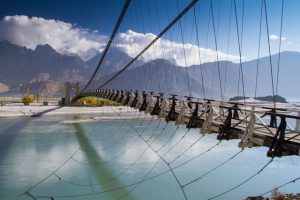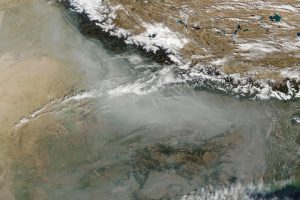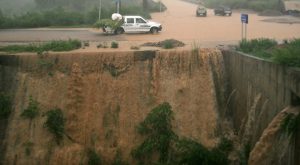Scientists have said precipitation – in the form of snow – at higher altitude areas where temperature remains below zero degrees of the Himalayas has been highly underestimated in the past. The research conducted in Upper Indus basin and published in Hydrology and Earth System Sciences claims that large glaciers in Upper Indus basin can be sustained only if snow accumulation is much higher than currently calculated amount which is based on satellite produced data or extrapolation of data obtained by direct observation at valley stations.
Total precipitation occurs as snow in the area where temperature remains below zero degrees that eventually feed the glaciers and slowly turns into ice.
Very few measuring stations at higher altitudes
Most often rainfall in the areas which lack measuring stations are calculated or predicted based on reconstructed data, which is a blend of site based measurement stations and satellite received information called “gridded datasets”. According to the researchers these datasets are the standard in assessment of water balance or hydrological assessment of any particular region. “We found that the high-altitude precipitation on average is more than twice as high and in extreme cases up to a factor of 10 higher than previously thought in Indus basin,” said Walter Immerzeel, Assistant Professor at Utrecht University’s in Neatherlands.
The Indus River originates from the mountains near Mansarovar lake in Tibet at an altitude of about five thousand metres and flows into the Arabian sea. It passes through the territories of China, India, Pakistan and Afghanistan.
Researchers said huge amount of precipitation is being missed currently as the stations in high altitude are highly inadequate. “Climate stations tend to be located where people live: in the valleys and at low elevations. In the Indus, where large amounts of snowfall occur in the winter due to westerly storms, the valleys are typically quite dry. This means the station network misses the amounts falling at higher elevations,” said Joseph Shea, Glacier Hydrologist at International Centre for Integrated Mountain Development (ICIMOD)—a regional mountain research centre headquartered in Kathmandu, Nepal.
The study includes glaciers with a surface area above 5 square kilometres. There are about 550 glaciers in Hindukush Himalayas, including the Karakoram range. “Current rainfall estimation in Upper Indus basin is at round 500 mm per year, which is almost half of the amount that is estimated by our study,” added Shea. However no datasets were obtained from the Chinese part of the Indus basin and most of the datasets used for the analysis were obtained from Pakistan. “We didn’t find weather stations on the Chinese part of the basin as it is the far west and remote area of the Tibetan plateau and not many stations are available there,” said Immerzeel at Utrecht University.
Indus Basin flow highly dependent on theoretical models
The magnitude and distribution of high-altitude precipitation is said to be least known in high altitude areas of the Himalayas and in depth research is largely inadequate. Of all Asian basins that find their headwaters in the greater Himalayas, the Indus basin depends most strongly on high altitude water resources. “In the absence of snow and rain measurements at high altitude in the Indus we needed another way to confirm our findings,” said Immerzeel. “We use observations of river flow and the results confirmed that the amount of water in the rivers can only be explained if the amount of snow and rain is as high as we estimated.”
Researchers used the snow melt amount as a basis to find out how much snow has to be accumulated in order keep existing river flow in the Indus. “We know the amount of ice lost through melting so were able to compute the amount of snow required to meet those conditions and then we measured the amount of water in the river flowing down to conclude how much rainfall has to occur to sustain those flow,” added Immerzeel.
The Himalayas and adjacent mountain ranges are an important source of water for more than 25 per cent of the global population. “Most precipitation at high altitude is now stored in the glaciers, but when global warming persists and the runoff regime becomes more rain dominated, the downstream impacts of our findings will become more evident,” said Marc Bierkens, Professor of Hydrology at Utrecht University.
Impossible to correctly predict future water flow
Scientists said understanding all elements of water balance in the river basins are very important and this aspect of rainfall in the high altitude is great importance to calculate future water flow in rivers in future. “It could be used while designing hydroprojects or any other water infrastructure like irrigation canals. Most importantly the impacts of climate change could be understood better if various aspects of water balance systems are precisely calculated,” said said Immerzeel.
Responding to the study, Professor Shakeel Ahmad Romshoo, who is the Head of the Department of Earth Sciences at the University of Kashmir, told thethirdpole.net that he had often observed that the observed precipitation 4 or 5 times higher compared to the nearest station down in the plains. He added that this underestimation of the precipitation has serious implications for understanding hydrologic, climatic, vegetation or any other land surface processes.
“The river flow calculated by using the models doesn’t match with the observed flow because of the input of underestimated precipitation in the modelling process,” added Romshoo. “It is therefore imperative that we strengthen the scanty (in most cases non-existent) network of meteorological stations in the high altitudes so that we are able to better predict future changes on climate and water flow in the region.”
![<p>There are very few meteorological stations at high altitudes in the Himalayas [image by Chris Marquardt]</p>](https://dialogue.earth/content/uploads/2016/01/Snow-Himalayas-Chris-Marquardt-300x200.jpg)





![Many varieties of dhekia xaak (fiddlehead fern), which are extensively used in Assamese cuisine are disappearing with the changing climate. [image by Wikimedia/Tammy]](https://dialogue.earth/content/uploads/2016/01/fiddlehead-ferns-300x187.jpg)


